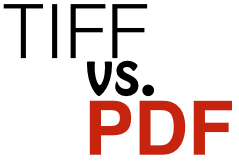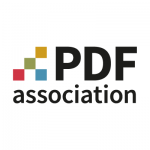
Regulatory factors pushing ECM from TIFF to PDF
A biplane is less complex than an airliner, but thats not a good reason to travel by Sopwith Camel! So it is with TIFF and PDF.
Todays ECM: Based on TIFF images
 The Enterprise Content Management (ECM) industry has been standardized on TIFF-encoded images for over 25 years. Billions of page images, most of them scanned from paper, populate hundreds of thousands of document management system installations worldwide. The ECM industry is comfortable with TIFF. While proprietary (Adobe owns it), TIFF is a relatively simple technology. The software engineering necessary to create and display TIFF images was brought to maturity decades ago. The ancillary features you might expect of documents; metadata, navigation, annotations and full-text search, among others, are instead features of document management software. Pages in TIFF are just pixels. This suits the industry just fine - keep all the valuable stuff in proprietary systems, deploy only "dumb" images.
The Enterprise Content Management (ECM) industry has been standardized on TIFF-encoded images for over 25 years. Billions of page images, most of them scanned from paper, populate hundreds of thousands of document management system installations worldwide. The ECM industry is comfortable with TIFF. While proprietary (Adobe owns it), TIFF is a relatively simple technology. The software engineering necessary to create and display TIFF images was brought to maturity decades ago. The ancillary features you might expect of documents; metadata, navigation, annotations and full-text search, among others, are instead features of document management software. Pages in TIFF are just pixels. This suits the industry just fine - keep all the valuable stuff in proprietary systems, deploy only "dumb" images.
PDF dominates in electronic documents
PDF is complex compared to TIFF, but many features users consider important are built right into the format. A biplane is less complex than an airliner, but thats not a good reason to travel by Sopwith Camel! PDF won the battle for dominant fixed-format electronic document years ago. The ECM industry noticed only in the sense that vendors recognized that they needed to be able to ingest PDF files, even if most treat PDF as if it were TIFF. But theres another angle, one the ECM industry hasnt yet come to grips with: PDF documents can be made accessible to users with disabilities, and TIFF images cannot.
Tomorrows ECM will have to be accessible
In the future the ECM/EDRM industry will be forced to abandon TIFF, and accessibility is one of the key reasons why. TIFF images are a non-starter in terms of accessibility. And the regulations are coming
Section 508 of the Rehabilitation Act regulates the documents created, distributed and procured by US federal government agencies. Many categories of documents will be obliged to comply with the refreshed Section 508 regulations for accessibility. These regulations (final NPRM released February 18, 2015) require conformance with either WCAG 2.0 or PDF/UA.
The Americans with Disabilities Act (ADA) requires covered employers to provide reasonable accommodations to employees with disabilities, and imposes accessibility requirements on public accommodations. Having announced its intention to address website accessibility in 2015 as part of updating ADA regulations for public accommodations, the DoJ is expected to require WCAG 2.0 conformance for websites, and if they follow the US Access Boards lead, which seems reasonable PDF/UA for PDF documents.
Where does this leave TIFF?
An essential aspect of accessibility is that images cannot substitute for documents. Government regulations will require that text, semantics and navigation, annotations, form-fields, digital signatures, and so on, be available to all users. TIFF images may be necessary for image data, but when a document is required, only PDF can really deliver. The sooner the ECM industry decides to engage with PDF on its own terms the sooner it will be able to address the oncoming need to provide an accessibility solution for enterprise content management.




